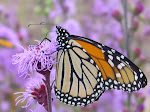Today I was driving over to a client's home this morning and I was listening to Minnesota Public Radio. Cathy Wurzer was interviewing entomologist Marla Spivack of the University of Minnesota about the continual decline of honeybees in the United States.
Spivack's voice wavered on air when she described how "bees are calling out for help", these bees need our help. I got a lump in my throat as I heard this. She said that our urban and agricultural environments are not hospitable to honey bees. Many flowers that bees pollinate are contaminated with residual herbicides, pesticides and fungicides.
When I heard urban environments are not hospitable. I began remembering how the herbicidal industry as a whole is a multi billion dollar industry and that agriculture cannot bear the brunt of blame for all that chemical use. Home owners in urban/suburban America use at least 50% of all herbicides.
Many flowers that are used in urban/suburban gardens or landscapes are not native. Many plants are cultivars that offer "perfect" looks but little ecological benefits (nectar) to insect pollinators or bees for that matter.
Gardeners in our society are taught to value "perfect" looking plants, and the minute insects take a nibble out of plants or a plant gets mildew; gardeners dowse plants with insecticides and fungicides. Native honey bees and introduced honey bees are paying the price with thier health and lives.
According to Spivack, when herbicides, pesticides and fungicides get into honey bees' bodies, they are weakened and become more susceptible to diseases and parasites. This apparently is the cause of colony collapse.
How can we help honey bees in the urban environment?
A.) We can reduce or eliminate harmful chemical uses.
B.) We can plant more flowers. And we can use various flowers (and wildflowers) that can offer nectar through the spring-summer-fall seasons.
C.) Spivack added that flowers from the mint family are especially valuable to honey bees. She mentioned Sage and Hyssop are very good. She also mentioned plants from the Composite Family or Asteraceae Family with is a massive group of plants which include a host of excellent native wildflowers.
D.) We can help restore natural corridors of prairie/savanna into or urban lands.
E.) Collectively, urban gardeners can install gardens using nectar rich native wildflowers and make positive impacts for the wellness of bees.
F.) Did you know that Minnesota is one of the largest honey producers in the United States?
26 March 2010
Subscribe to:
Post Comments (Atom)


No comments:
Post a Comment